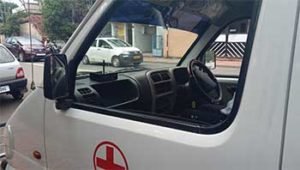 Unscientifically designed signal timings tempt the drivers for red jumping either due to inadequate green time or unacceptable red time. Re-timing signals in frequent interval is not a practical proposition. Implementations of vehicle actuated signal controllers possess greater challenges due to the nonlane based driving and highly heterogeneous traffic.
Unscientifically designed signal timings tempt the drivers for red jumping either due to inadequate green time or unacceptable red time. Re-timing signals in frequent interval is not a practical proposition. Implementations of vehicle actuated signal controllers possess greater challenges due to the nonlane based driving and highly heterogeneous traffic.
The researches funded by the Department of Electronics and Information Technology, and Government of India have resulted in successful development of affordable and effective solution for vehicle actuated signal controllers and Adaptive Traffic Control System (ATCS) addressing the typical traffic conditions in India. Developing countries having similar traffic characteristics can model the solution developed for Indian cities. The ATCS continuously retimes the signals based on real-time traffic demand and maintain synchronized signal corridors for better travel times. Optimum signal timings reduce the chances of red jumping caused by inappropriate signal timings. However, this is not sufficient to stop drivers jumping red; it requires effective enforcement. Red light violation detection system (RLVDS) uses combination of sensors and cameras to identify red jumping and generate evidence of the violation.
The RLVDS electronics interfaced with the Red and Green signal lamps of the traffic junction identifies the red running vehicle with the help of vehicle detection cameras and snapshots of vehicle progressing through the junction while the signal was Red, provided evidence of the violation. The RLVDS also provides video of the vehicle jumping the Red. The number plate captured using ANPR Camera is processed to extract the vehicle registration details and booking the vehicle automatically. Speed limit and lane change violations are detected and reported using video analytics. Violation of red light and speed limit cause safety concerns.
Clearing of Emergency Service Vehicles (ESV) caught in Red signal often follow dangerous procedures to cross the junction in the run to save a life or reaching at a disaster site quickly. Many a time, the ESV take the wrong lane to cross the junction as it is difficult to squeeze through the vehicles queued in Red signal. If the median restrict the ESV to change lane, the officer at the traffic junction place himself in the middle of the road and allow the vehicles to clear through Red, creating conflicting situation and confusion at the junction.
 Indigenous solutions are available in the Country for prioritizing ESVs at signalized traffic junctions. The ESV Priority System (ESVPS) installed inside the emergency service vehicle establish communication with the traffic signal controller as it approaches the traffic junction (approximately 300-400mtr before the stop-line) and request for a priority signal by the time the vehicle reaches the junction. The traffic signal controller then responds to this priority call and keeps the right-of-way open for the ESV by stopping movement from all other approaches. A ‘Hooter’ will be activated at the traffic junction to alert the pedestrians, drivers and the officer manning the junction about the arrival of the ESV. The signal will be restored to its normal operation once the ESV is cleared through the junction.
Indigenous solutions are available in the Country for prioritizing ESVs at signalized traffic junctions. The ESV Priority System (ESVPS) installed inside the emergency service vehicle establish communication with the traffic signal controller as it approaches the traffic junction (approximately 300-400mtr before the stop-line) and request for a priority signal by the time the vehicle reaches the junction. The traffic signal controller then responds to this priority call and keeps the right-of-way open for the ESV by stopping movement from all other approaches. A ‘Hooter’ will be activated at the traffic junction to alert the pedestrians, drivers and the officer manning the junction about the arrival of the ESV. The signal will be restored to its normal operation once the ESV is cleared through the junction.
Pedestrian signals at traffic junctions and mid-block pedestrian crossings are generally timed for normal pedestrians. They totally ignore differently able and visually challenged. Recent advancements in ITS has come out with differently able friendly pedestrian signal controllers. They generate various tones for the visually challenged to locate the pedestrian crossing, wait for pedestrian signal, safe crossing time and ‘do not cross’ time. The visually and physically challenged, women, children and elderly people can demand for more crossing time through RFID cards. Once the RFID is detected, the pedestrian crossing time is increased to meet the requirement of the pedestrian. The pedestrian signals will operate with standard crossing time when there is no request for additional pedestrian time.
The Government has started implementing Road Accident Data Management System (RADMS) for authentic and scientific recording of accident data for analysis. Classified data of vehicles involved in the accident, age and gender of driver / pedestrians, time of accident, type of injury etc. will be recorded in the RADMS through multiple sources.
Surveillance cameras and Control Command Centre (CCC) are being implemented widely in Indian cities to improve road safety. The cameras monitored from the CCC are highly helpful in detecting accidents at traffic junctions and road stretch and moving medical aid to the accident spot quickly. The world is moving towards connected cars, autonomous vehicles and intelligent roads with a vision to improve efficiency and road safety. Size of the country, vehicle population, limited investment in core research and development etc. are some of the factors to be addressed. Hopefully, India will be soon opened to connected vehicles, autonomous vehicles and intelligent roads for better safety in the near future.
 TrafficInfraTech Magazine Linking People Places & Progress
TrafficInfraTech Magazine Linking People Places & Progress


